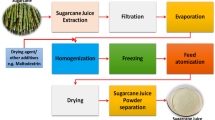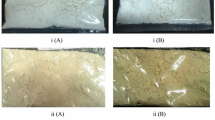Abstract
The aim of this work was to determine the best operating condition for spray drying prebiotic pineapple, melon, and orange drinks. Maltodextrin and Arabic gum were evaluated as drying adjuvant at two different drying temperatures (160 and 180 °C). The best operating condition was inlet air temperature of 180 °C, atomizer nozzle flow rate at 30 L/min, inlet air-drying flow rate at 3.5 m3/min and feed flow rate at 0.3 L/h with 20 % (m/m) of maltodextrin. The powders presented low water activity (a w ≤ 0.200) and low moisture (0.267–0.733 %). The rehydration time ranged from 90 to 144 s, the powder hygroscopicity from 5.17 to 7.48 % in dry basis, and the degree of caking from 24 to 67 %. The instrumental color difference was below the threshold for the human eye perception for all drinks.
Similar content being viewed by others
References
Abadio, F. D. B., Domingues, A. M., Borges, S. V., & Oliveira, V. M. (2004). Physical properties of powdered pineapple (Ananascomosus) juice—effect of malt dextrin concentration and atomization speed. Journal of Food Engineering, 64, 285–287.
AOAC-Association of Official Analytical Chemists. Official Methods of Analysis of the Association of Official Analytical Chemists, (method 934.06). Arlington: A.O.A.C., 1995. Chapter 37. p. 4.
Chegini, G. R., & Ghoabadian, B. (2007). Spray dryer parameters for fruit juice drying. World Journal of Agricultural Sciences, 3, 230–236.
Fabra, M. J., Márquez, E., Castro, D., & Chiralt, A. (2011). Effect of maltodextrins in the water-content water-activity glass transition relationships of noni (Morindacitrifolia L.) pulp powder. Journal of Food Engineering, 103, 47–51.
Fang, Z. X., & Bhandari, B. (2011). Effect of spray drying and storage on the stability of bayberry polyphenols. Food Chemistry, 129, 1139–1147.
Fang, X., Wang, J., Zhou, H., Jiang, X., Zhang, G., & Zhang, D. (2011). Multiple response optimization of spray-drying process for the preparation of salvianolic acids microparticles and evaluation for potential application in dry powder inhalation. Drying Technology, 29, 573–583.
Fazaeli, M., Eman-Djomeh, Z., Ashtari, A. K., & Omid, M. (2012). Effect of spray drying conditions and feed composition on the physical properties of black mulberry juice powder. Food and Bioproducts Processing, 90, 667–675.
Fontes, C. P. M. L. (2013). Produção de oligossacarídeos prebióticos em suco de frutas. PhD Thesis, Federal Universityof Ceará, Rede Nordeste de Biotecnologia (RENORBIO), 119 p.
Fox, D., & Robyt, J. F. (1991). Miniaturization of three carbohydrate analysis using a microsample plate reader analyses. Analytical Biochemistry, 195, 93–96.
Gabas, A. L., Telis, V. R. N., Sobral, P. J. A., & Telis-Romero, J. (2007). Effect of maltodextrin and arabic gum in water vapor sorption thermodynamic properties of vacuum dried pineapple pulp powder. Journal of Food Engineering, 82, 246–252.
Gharsallaoui, A., Roudaut, G., Chambin, O., Voilley, A., & Saurel, R. (2007). Applications of spray-drying in microencapsulation of food ingredients: an overview. Food Research International, 40, 1107–1121.
Goula, A. M., & Adamopoulos, K. G. (2008). Effect of maltodextrin addition during spray drying of tomato pulp in dehumidified air: II. Powder properties. Drying Technology, 26, 726–737.
Goula, A. M., & Adamopoulos, K. G. (2010). A new technique for spray drying orange juice concentrate. Innovative Food Science and Emerging Technologies, 11, 342–351.
Grabowski, J. A., Truong, V. D., & Daubert, C. R. (2006). Spray-drying of amylase hydrolyzed sweet potato puree and physicochemical properties of powder. Journal of Food Science, 71, E209–E217.
Grabowski, J. A., Truong, V. D., & Daubert, C. R. (2008). Nutritional and rheological characterization of spray dried sweet potato powder. LWT--Food Science and Technology, 41, 206–216.
Hossain, M. A., & Rahman, S. M. M. (2011). Total phenolics, flavonoids and antioxidant activity of tropical fruit pineapple. Food Research International, 44(3), 672–676.
Ismail, H. I., Chan, K. W., Mariod, A. A., & Ismail, M. (2010). Phenolic content and antioxidant activity of cantaloupe (Cucumis melo) methanolic extracts. Food Chemistry, 119, 643–647.
Jaya, S., & Das, H. (2004). Effect of maltodextrin, glycerol monostearate and tricalcium phosphate on vacuum dried mango powder properties. Journal of Food Engineering, 63, 125–134.
Jayasundera, M., Adhikari, B., Aldred, P., & Ghandi, A. (2009). Surface modification of spray dried food and emulsion powders with surface-active proteins: a review. Journal of Food Engineering, 93, 266–277.
Jiménez-Aguilar, D. M., Ortega-Regules, A. E., Lozada-Ramírez, J. D., Pérez-Pérez, M. C. I., Vernon-Carter, E. J., & Welti-Chanes, J. (2011). Color and chemical stability of spray-dried blueberry extract using mesquite gum as wall material. Journal of Food Composition and Analysis, 24, 889–894.
Jittanit, W., Niti-Att, S., & Techanuntachaikul, O. (2010). Study of spray drying of pineapple juice using maltodextrin as an adjunct. Chiang Mai Journal of Science, 37, 498–506.
Kha, T. C., Nguyen, M. H., & Roach, P. D. (2010). Effects of spray drying conditions on the physicochemical and antioxidant properties of the Gac (Momordica cochinchinensis) fruit aril powder. Journal of Food Engineering, 98, 385–392.
Kurozawa, E. L., Park, K. J., & Hubinger, M. P. (2009). Effect of maltodextrin and gum arabic on water sorption isotherms and glass transition temperature of spray dried chicken meat hydrolysate protein. Journal of Food Engineering, 91, 287–296.
León-Martínez, F. M., Méndez-Lagunas, L. L., & Rodríguez-Ramírez, J. (2010). Spray drying of nopal mucilage (Opuntiaficus-indica): effects on powder properties and characterization. Carbohydrate Polymers, 81, 864–870.
Moreira, G. E. G., Costa, M. G. M., de Souza, A. C. R., de Brito, E. S., de Medeiros, M. F. D., & de Azeredo, H. M. C. (2009). Physical properties of spray dried acerola pomace extract as affected by temperature and drying aids. LWT--Food Science and Technology, 42, 641–645.
Mussatto, S. I., & Mancilha, I. M. (2007). Non-digestible oligosaccharides: a review. Carbohydrate Polymers, 68, 587–597.
Peng, Z., Li, J., Guan, Y., & Zhao, G. (2013). Effect of carriers on physicochemical properties, antioxidant activities and biological components of spray-dried purple sweet potato flours. LWT--Food Science and Technology, 51, 348–355.
Pereira, A. L. F., Almeida, F. D. L., de Jesus, A. L. T., da Costa, J. M. C., & Rodrigues, S. (2013). Storage stability and acceptance of probiotic beverage from cashew apple juice. Food and Bioprocess Technology, 6(11), 3155–3165.
Quek, S. Y., Chok, N. K., & Swedlund, P. (2007). The physicochemical properties of spraydried watermelon powder. Chemical Engineering and Processing, 46, 386–392.
Rabelo, M. C., Honorato, T. L., Gonçalves, L. R. B., Pinto, G. A. S., & Rodrigues, S. (2006). Enzymatic synthesis of prebiotic oligosaccharides. Applied Biochemistry and Biotechnology, 133, 31–40.
Rabelo, M. C., Fontes, C. P. M. L., & Rodrigues, S. (2009). Enzyme synthesis of oligosaccharides using cashew apple juice as substrate. Bioresource Technology, 100, 5574–5580.
Ramallo, L. A., & Mascheroni, R. H. (2012). Quality evaluation of pineapple fruit during drying process. Food and Bioproducts Processing, 90, 275–283.
Rastall, R. A. (2010). Functional oligosaccharides: application and manufacture. Annual Reviews in Food Science and Technology, 1, 305–339.
Rodríguez-Hernández, G. R., González-García, R., Grajales-Lagunes, A., & Ruiz-Cabrera, M. A. (2005). Spray-drying of cactus pear juice (Opuntia streptacantha): effect on the physicochemical properties of powder and reconstituted product. Drying Technology, 23, 955–973.
Shrestha, A. K., Howes, T., Adhikari, B. P., & Bhandari, B. R. (2007). Water sorption and glass transition properties of spray dried lactose hydrolysed skim milk powder. LWT- Food Science and Technology, 40, 1593–1600.
Silva, I. M., Rabelo, M. C., & Rodrigues, S. (2012). Cashew juice containing prebiotic oligosaccharides. Journal of Food Science and Technology. doi:10.1007/s13197-012-0689-9 (online first).
Solval, K. M., Sundararajan, S., Alfaro, L., & Sathivel, S. (2012). Development of cantaloupe (Cucumis melo) juice powders using spray drying Technology. LWT--Food Science and Technology, 46, 287–293.
Tonon, R. V., Brabet, C., & Hubinger, M. D. (2008). Influence of process conditions on the physicochemical properties of açai (Euterpe oleraceae Mart.) powder produced by spray drying. Journal of Food Engineering, 88, 411–418.
Viganó, J., Azuara, A., Telis, V. R. N., Beristain, C. I., Jiménez, M., & Telis-Romero, J. (2012). Role of enthalpy and entropy in moisture sorption behavior of pineapple pulp powder produced by different drying methods. Thermochimica Acta, 528, 63–71.
Acknowledgments
The authors thank CNPq through the National Institute of Tropical Fruits (INCT-FT-CNPQ) for the financial support and scholarship and CAPES for the scholarship.
Author information
Authors and Affiliations
Corresponding author
Rights and permissions
About this article
Cite this article
Fontes, C.P.M.L., Silva, J.L.A., Sampaio-Neta, N.A. et al. Dehydration of Prebiotic Fruit Drinks by Spray Drying: Operating Conditions and Powder Characterization. Food Bioprocess Technol 7, 2942–2950 (2014). https://doi.org/10.1007/s11947-014-1343-5
Received:
Accepted:
Published:
Issue Date:
DOI: https://doi.org/10.1007/s11947-014-1343-5




